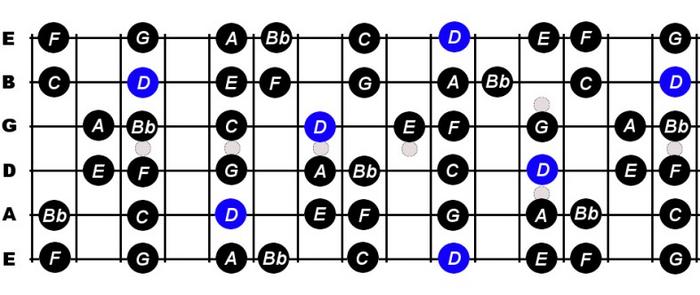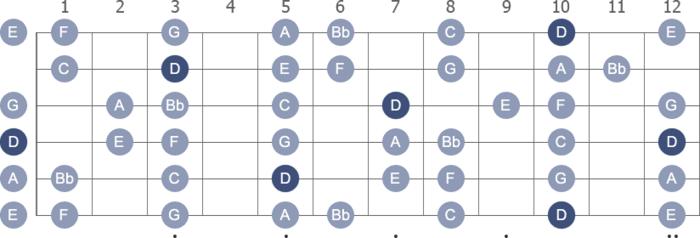The first time I brushed my fingers across the fretboard and played the D minor scale, I didn’t anticipate the *emotional resonance* it would unlock. Little did I know, this seemingly simple progression would become a cornerstone in my musical journey, bridging *deep connections* between my playing and the listeners’ emotions. As an experienced guitarist and music theorist, I’ve come to understand that the D minor scale isn’t just another scale to master—it’s an invitation to explore the *depths of your soul*. What is it about these haunting tones that captivate us so intensely?
In this article, we will delve into the captivating world of the D minor scale, unpacking its nuances and teaching you how to harness its full potential on the guitar. From understanding its notes and finger positions to crafting melodies that touch the soul, you’ll learn how to wield this natural minor scale not just as a technical exercise, but as a profound tool for artistic expression. Let’s embark on this journey together, unlocking the secrets of the D minor scale one step at a time.
Understanding the D Minor Scale

Understanding the D minor scale is like uncovering the emotional heart of your music. When I first started delving into music theory, the world of scale intervals caught me by surprise. It’s not merely an academic exercise; it’s how I learned to communicate with my guitar and capture the essence of what I wanted to express. Did you know that the intervals in a minor scale play a crucial role in shaping the emotional context of your music? This realization marked a turning point in my musical journey. It was not just about playing notes in a sequence; it was about feeling each note’s impact and the way they weave together to create something truly evocative.
The D natural minor scale, in particular, carries a deep, soulful quality. Its distinctive tone is defined by its intervals: the whole and half steps that set it apart from its major counterpart. Through my own practice, I discovered that each interval has its own mood and character, and understanding this interplay is crucial. Mastery of scale intervals allows us to harness the full emotional power of the D minor scale, whether I’m crafting somber melodies or embarking on an improvisational journey. With knowledge of these subtle nuances, I’ve been able to infuse my music with authenticity, making each performance resonate with both me and my audience.
Notes of the D Minor Scale

When I first embarked on my journey to transcribe music, decoding the notes of different scales was akin to unraveling a complex but rewarding puzzle. The D minor scale was no different—its haunting tonality and rich emotional depth immediately captivated me. Imagine unlocking the emotional potential of your guitar by mastering just a handful of notes—what would that mean for your playing?
Understanding the D minor scale opens up a world of musical possibilities. The scale consists of a specific series of notes: D, E, F, G, A, B♭, and C. Each contributes a distinct flavor to your music, creating a tapestry of sound that is both melancholic and expressive. By delving into the numerous fretboard positions, you can discover how the scale transcends its simple structure to offer versatility in playing.
What fascinated me initially was how the D minor scale could be played across various scale diagrams. Whether at the first position or further up the neck, it led me to a deeper appreciation of how positional play can unlock new ways of expressing a melody. Through this exploration, I’ve become attuned to the subtle shifts in emotion that each position offers, enhancing my musical narratives.
As you integrate these notes into your playing, you’ll find you have the tools needed to infuse your music with profound emotions. This mastery not only enriches your skillset but ultimately transforms your guitar playing into a deeply personal and evocative art form.
Finger Positions for D Minor

What if the way you position your fingers could drastically change the sound and feel of your solos? This question, once just a fleeting thought, transformed my approach to guitar playing. Over my years of practice, I’ve discovered that the right finger positions can open the door to limitless creativity. It’s certainly not just about placing your fingers in pre-charted spots—it’s about understanding and feeling the fretboard.
Let’s delve into how you can master D Minor with optimal finger positioning. Start by familiarizing yourself with scale diagrams. These visual guides are foundational tools that can help you understand the landscape of your guitar neck. As you study these diagrams, focus on minimizing unnecessary finger movements. Effortless transitions between notes lie at the heart of smooth guitar techniques. Position your fingers with precision, especially for the root note on the fifth string’s fifth fret—a key anchor point in the D Minor scale.
As you explore these positions, remember that personal touch makes all the difference. Don’t shy away from making slight adjustments to suit your hand’s natural movement and reach. Over time, what feels awkward will become smooth and intuitive, morphing into an extension of your inner musical voice. Trust in the potential of these subtle tweaks and watch your guitar solos transform in ways you never thought possible.
Exercises to Master the D Minor Scale

Think about this: how many times have you found yourself playing the same licks? What if a few targeted exercises could break you out of that rut? Over my years of teaching and playing guitar, I’ve come to realize that mastering scales opens doors to countless musical possibilities. The D minor scale, with its haunting tones, is no exception. The key to truly conquering it is through practical exercises meticulously designed to enhance your guitar techniques.
One of my favorite exercises involves linking the D minor scale with its counterpart, the minor pentatonic scale. By alternating between the two, you not only familiarize yourself with their distinct tonal qualities but also learn to transition seamlessly between them. This exercise greatly enhances your ability to craft emotionally charged solos.
Another powerful method is to focus on ascending and descending sequences within the scale. Start slowly, first emphasizing each note, then progressively increase your speed. You’ll notice an improvement in your finger dexterity and a clearer understanding of the scale pattern across the fretboard.
Incorporating these exercises into your practice routine is akin to laying the groundwork for building melodies in D minor. By investing in these foundational exercises, you set yourself up for success in crafting compelling guitar solos and building your improvisational skills.
Building Melodies in D Minor

Have you ever thought about how a simple melody can tell a story without words? As an editor and writer who often dives into the narrative capabilities of music, I’ve found that the D minor scale on the guitar offers a particularly compelling canvas for storytelling through sound. This scale, known for its haunting and melancholic tones, is a fertile ground for building melodies that resonate deeply with listeners.
When crafting a guitar melody in D minor, each note becomes a character in your story, each chord a chapter. These melodic elements intertwine to create an emotional tapestry that can evoke everything from longing to triumph. The process of music composition in this scale is akin to weaving narratives that speak directly to the heart, bypassing the need for words.
Over the years, I’ve honed techniques to guide students in unlocking the full potential of building melodies in D minor. By focusing on techniques such as varying rhythm, exploring dynamic range, and emphasizing emotional contrast, a composer can enhance this innate expressive quality of the scale. This approach not only enriches the melodic storytelling but also allows the musician to carve out a signature sound.
As you delve into building your own melodies in D minor, remember that you are crafting a dialogue—a musical conversation that invites the listener to explore the depths of feeling and imagination. With practice, you’ll discover that this scale is not just a collection of notes but a gateway to a powerful narrative expression.
Improvisation Techniques in D Minor

Improvisation is where I’ve truly found my voice as a musician. Exploring the D minor scale’s depths and its related modes, like the D Aeolian mode, offers boundless opportunities for expression on the guitar. What if improvisation could be your most powerful tool for musical expression—would you dare to experiment?
Diving into guitar improvisation in D minor isn’t just about playing notes in a sequence; it’s about crafting stories with sound. Imagine each note as a word and each passage as a sentence in your evolving narrative. To start, familiarize yourself deeply with the D minor scale’s distinctive mood—a mood that’s both melancholic and mysterious. This scale becomes a canvas for painting emotions, where each lick or riff you create adds a brushstroke to your aural masterpiece.
The key to unlocking creativity lies in modal scales. Within D minor, the D Aeolian mode serves as your core palette. Experiment with varying your rhythm, pace, and dynamics. Play around with the scale sequences, weaving them with spontaneous bends and slides that evoke emotion. This is where you find your distinct voice in music, where structured sessions evolve into spontaneous symphonies.
Your improvisation should be as natural as breathing, each session bringing surprises that deepen your connection with the guitar. As you practice, let the music guide you, giving each note space to breathe and resonate. In doing so, you’ll cultivate an authentic sound that is distinctly your own, embracing the vast, expressive terrain that improvisation in D minor opens up.
Conclusion
As you close this guide, ask yourself: how will you use the D minor scale to transform your music? Reflecting on my experiences, I realize that mastering the scales we love, like the D minor, shapes not just our playing but our understanding of music as a whole. Each section of this guide has furnished you with vital insights into the beauty and versatility of the D minor scale—starting with the fundamental notes to exploring finger positions for an expansive reach across your guitar. You’ve learned how to craft evocative melodies and improvise with confidence, leveraging the distinctive mood the D minor scale offers.
The deeper understanding you’ve gained of music theory will empower you to integrate this knowledge into your compositions. The D minor scale is not merely a sequence of notes but a canvas for your creativity, offering endless possibilities for musical expression. Now, your challenge is to practice, experiment, and let the D minor scale inspire your unique sound.
FAQs

